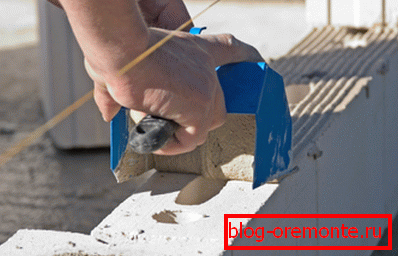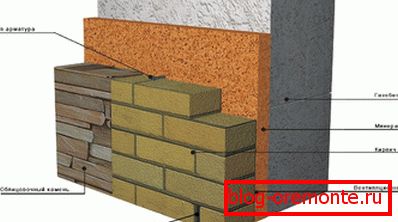What to choose for construction - aerated or foam concrete
During preparation for the construction work, developers have to choose the most efficient materials, and very often the choice is difficult enough, as the market offers a wide range. .
To begin with, it is necessary to determine how both materials are made, as a result of which it will be possible to obtain their positive and negative physical properties.

By their nature, foam concrete and aerated concrete are cellular type concrete. Their main difference lies in the manufacturing process, as well as in further use. Let's talk about each type separately and consider what is stronger.
Foam concrete
Instructions for production is simple. This material consists of concrete and specially prepared foam, which are mechanically mixed. In the frothers there is air, which forms the hollow cells in the final material.
For mixing using a sealed tank. After obtaining a homogeneous mass, it is fed under pressure to the forms. In the future, the material is used during various construction works. In fact, foam concrete can be made by hand, which cannot be said about aerated concrete, where technology is much more complicated.

What properties of foam concrete make customers during the design make a choice in his favor?
Benefits
- The material is quite reliable. Time does not affect it, so the life of a building constructed using foam concrete is very long. It also does not rot, and has the same strength characteristics as a stone.
- Good thermal insulation. The use of this building material in the construction of the house will significantly reduce the cost of heating in the winter. This can also be attributed, and excellent sound insulation qualities, thanks to which it can be used without additional sound insulation in large noisy cities.
- With its help, a special microclimate is created in the room, as a result of which it is not cold in the winter and not hot in the summer. Such characteristics are due to the fact that this material can not only absorb, but also give off moisture, depending on the ambient temperature. Therefore, it will be warm in winter concrete houses and cool in summer.
- The next advantage of the material is its environmental friendliness. (inferior in this indicator only to the tree). During its operation no harmful substances get into the air, so it is ideal for the construction of residential buildings.
- In addition, the foam does not burn. This is a very significant advantage for building in fire hazard areas. Studies have shown that a layer of 150 mm is able to withstand the effects of fire for four hours.
Tip: a small number of components, their availability and unpretentiousness make it possible to produce foam concrete even in concrete mixers.
And the last in the list, but not the last in practice advantage of foam concrete is the simplicity of its processing. Although this material is highly durable, it easily lends itself to any of its form, with the result that any architectural form can be made from such blocks. You do not need such a type of material processing as cutting a reinforced concrete with diamond circles, because a saw is suitable for this and simple.

Gas concrete
To obtain cells in such concrete, gases are used that are formed as a result of a chemical reaction that occurs during the mixing of the components. At the beginning of the last century, two American scientists Aulsworth and Dyer conducted experiments with cement-lime mortar.
It turned out that when aluminum powder is added to it, its structure becomes porous. The idea came to taste, so that aluminum powder is still used to make aerated concrete.

The composition of the now produced aerated concrete includes:
- cement;
- quartz sand;
- blowing agents (aluminum powder or paste) with the possible addition of lime or gypsum.
In addition, sometimes slags or ash are added to the mixture, i.e. industrial waste. To obtain aerated concrete all components are thoroughly mixed with the addition of water. After that, the mixture is laid out in a form, where the process of gas formation occurs, the result of which is the production of hydrogen.
This gas forms the cells in the raw material, as a result of which it rises like dough. Then follows the process of primary solidification. After it is completed, the material can be cut, depending on the needs, into panels, blocks or slabs.
The next step is the steam treatment carried out in an autoclave. At this stage, the material appears the desired stiffness. Alternatively, it can be dried using electric heating. Depending on which of the solidification options was chosen, the aerated concrete will be autoclaved or non-autoclaved.

pros
Let's now take a look at the main advantages of aerated concrete in comparison with foam concrete:
- due to the controllability of the autoclaved production process, the material gets more stable characteristics;
- strength and thermal insulation characteristics of this material is better than that of foam concrete;
- it is more economical, because its production requires a smaller amount of cement;
- simpler processing (comparable with these characteristics with a tree).
The disadvantages of cellular concrete
Gas concreteные блоки или пенобетонные блоки имеют ряд недостатков, среди которых выделяется их несущая способность.
There are three types of concrete density:
- constructional;
- construction and heat insulation;
- heat insulating.
For example, the second is suitable for the construction of houses, three floors high. But do not forget about the fragility of such a material as aerated concrete. Therefore, such construction will require additional reinforcing reinforced concrete belt, which will significantly increase the final construction estimate, as well as reduce the insulation performance.
Such a negative property as brittleness reduces the strength of the material to bend, so it can not be called elastic. Consequently, even with the most insignificant deformations of the blocks, there is a probability of the appearance of cracks along their entire surface. That is why most often aerated concrete is used in conjunction with monolithic strip type foundations, as well as for the construction of basements of concrete buildings.
Tip: if you need to make a through channel at the base of the house, you will be helped by a service - diamond drilling of holes in concrete with special tools.
Another negative quality of the material consumers get acquainted already in the process of operation. The fact is that in the usual way to fix the bracket in the wall or install any shelf, it will not work. To do this, you will need to use special mounts.

The following negative property of the material is often silenced, but this is not worth doing, it is hygroscopic. The fact is that aerated concrete very easily absorbs vapors and moisture, which adversely affects the overall insulation of the room. To solve the problem, you can brick walls, however, this will increase not only the overall estimate of work, but also their duration.
So far, it’s impossible to judge how durable this material is, because He began to use in construction less than 40 years ago.

Also, aerated concrete has low frost-resistant qualities. If, for example, to compare it with a silicate brick, which is able to withstand up to 50 cycles, aerated concrete with its 25 cycles will be an outsider.
And finally, the process of manufacturing autoclaved aerated concrete itself is quite expensive, and also for its adjustment requires the involvement of huge production capacity. In addition, the price of equipment may vary within a dozen, or even hundreds of millions of rubles.
Conclusion
Taking into account the arguments of the builders, to answer the question - what is better foam concrete or aerated concrete is possible only from a relative point of view. This is due to the characteristics of materials and their ability to fulfill certain construction requirements. In fact, both of them are cellular concretes, which require special treatment during their work. The video in this article will help you find additional information on this topic.